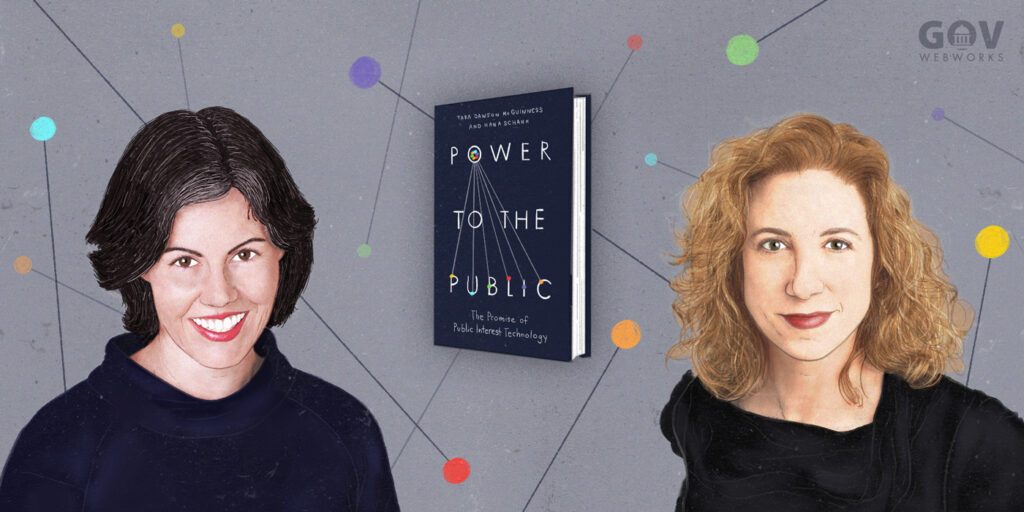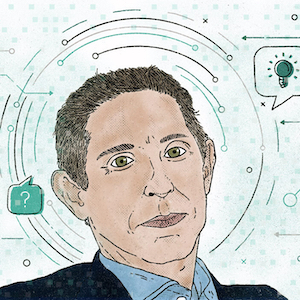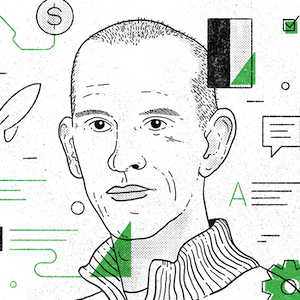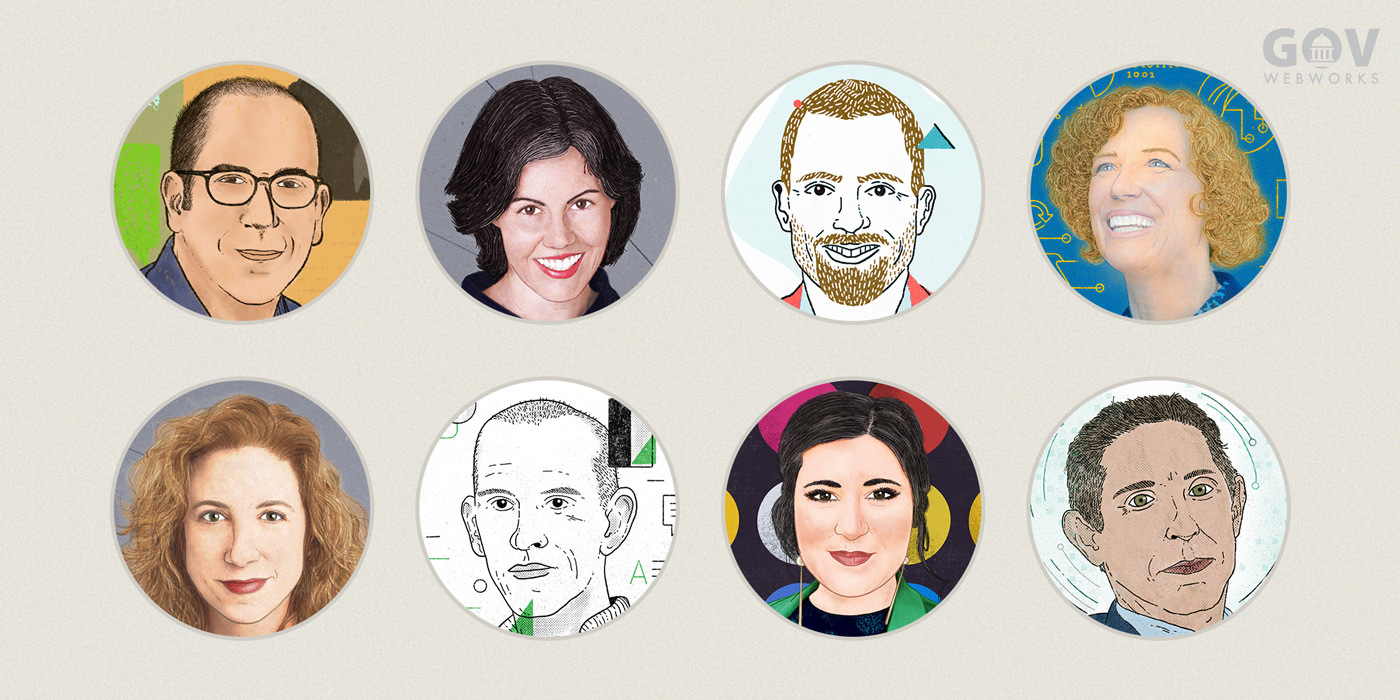Our Insider Insights interviews bring together insights from authors, consultants, coaches, and other industry experts on topics relating to online digital innovation.
Find highlights from some of our recent guests, with links to full interviews, below. Topics include public interest technology by Tara McGuinness and Hana Schank, Michael Sahota on evolutionary agile leadership, Katie Swindler on user-centered design, and content strategy with Padma Gillen.
See Industry Experts: Volume II for further insights on civic tech from Cyd Harrell, conversation design with Jon Bloom, information architecture with Abbey Covert, and modernizing online benefits with Jamie Brennan.

Tara McGuinness and Hana Schank: Authors and civic tech advocates
Improving design and delivery of online services
“The field of public interest technology is having a moment,” says Tara McGuinness, co author with Hana Schank of Power to the Public: The Promise of Public Interest Technology. The book defines public interest technology (PIT) as the application of data, design, and delivery to advance the public interest and promote the public good in the digital age. The “three Ds” are shorthand for the combination of using real-time data to guide problem solving, understanding human needs to inform design, and incremental delivery to allow for continuous improvement.
How does public interest technology benefit government?
“We can restore trust in government if people’s lived experience with government makes them feel seen, heard, and understood. User-centered methods of allowing voice and contributions in a tighter feedback loop are really important to that.
“Part of meeting user needs upholds a democratic principle of ‘Am I heard? Does anyone understand what my life is like? I pay taxes, this is my city, county, state. Is the government working for me?”
Michael Sahota: Author and agile coach
Shifting to a people-centric mindset

Michael and his partner, Audree Sahota, authors of Leading Beyond Change, work with leaders who have struggled with agile transformations. “Agile is part of the approach,” Michael tells them. “But leaders don’t need to learn Scrum, they need to learn how to function as an evolved leader. That’s the missing ingredient in lots of agile transformations. If leaders don’t change the way they lead, how can the organization change?”
The key, Michael says, lies in the shift to a people-centric way of working, or “people over process.” But for that to happen, leaders need to shift to an evolutionary mindset first.
What is the goal of evolutionary leadership?
“Our view is that there is a path forward if we change how the leaders in organizations function. If we change the leadership, that changes the fabric of the organization. People will experience positivity where it’s a joy coming into work, instead of negativity and oppression. That changes the organizational systems, which touches the products and customers, and the families of those workers, and the communities that they live in.
When we tip the leadership, that pulls all the people along and uplifts the whole system. High performance is achievable, business agility is achievable, but it starts within each of us as individuals making a choice to show up differently.”
Katie Swindler: Author and designer
De-escalating stress and reducing bias online

Katie’s book, Life and Death Design: What Life-Saving Technology Can Teach Everyday UX Designers, is the result of her research into the stress response. The head of design for Allstate Insurance’s Innovation team, and an author and presenter on UX and design topics, Katie’s goal is to minimize stress for people using technology tools.
What are some simple ways designers can adjust designs for people under stress?
“If you are designing for someone who is stressed, you’ll want to go as far as you reasonably can to increase the size of your buttons, text, and the space surrounding your controls while still keeping a reasonable amount of content on the screen.
I encourage people to think critically about the specific situation they are designing for and widen the range of the human behavior that is accommodated by the design as much as possible. This is a better way to approach design than relying on standard minimums that assume the design is being used by fully rational users in a calm, quiet environment.”
Padma Gillen: Author and content strategist
Creating successful content for successful users

In Lead With Content: How to put content at the center of digital transformation, Padma Gillen points out an important reminder for content managers. Successful content (the information on a website or application) is not so much about sentence structure or what images are used, but how well the information meets user needs.
Padma’s approach to agile content production and addressing user needs is based on his experience as head of content design during the award-winning redo of GOV.UK. Now, as a content strategy consultant and co-founder of Llibertat, Padma isn’t telling content managers how to write, he’s showing them how to produce the right content for their specific audience.
What tips do you give for writing successful online content?
“One, work out the user need and focus the content on that, and two, keep it as short as possible. That’s it.
Within that, you can look at how you structure the content so it’s as intuitive as possible for the highest number of people. What data do you have to support your decisions? And how does this user need relate to that user need, or how do you join these things together into journeys?”
Learn more
- Public Sector Insider Insights Tips: Download tips from top minds on how to succeed in gov tech
- Industry Experts Series: Volume I with Tara McGuinness and Hana Schank on public interest technology, Michael Sahota on evolutionary agile leadership, Katie Swindler on user-centered design, and Padma Gillen on content strategy.
- Industry Experts Series: Volume III with Mary Uhl-Bien on adapting to change, Iain Kerr and Jason Frasca on fostering innovation, Jennifer Pahlka on changing the culture of gov tech, Kristen Cox on how to be more effective, Bob Galen on adopting agile coaching skills, Jenn Page on tools for online education, Lainey Feingold on building a culture of accessibility.
- Contact us to learn more about how digital tools help government adapt to change
Join our team
We’d love to hear from you. We have a variety of remote and hybrid positions available.
- Check out our current job openings
- Contact us with any questions
- See PWW/GWW clients: Portfolio of work
- Visit us on social media: LinkedIn, Facebook, Twitter
